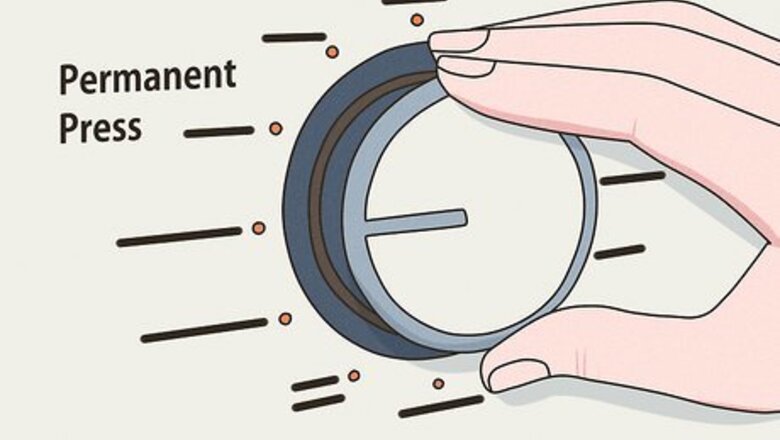
views
- Permanent press is a setting on a washer or dryer that prevents wrinkles. It can also refer to wrinkle-resistant fabrics made from synthetic fibers, like spandex.
- Use permanent press for items that feature the permanent press symbols on their tags. There are two symbols: one for washing, and one for drying.
- You can also permanent press on mildly soiled, lightweight items like shirts, pants, and dresses. Avoid using it for very soiled or heavy fabrics like towels or jeans.
What is a permanent press?

Permanent press is a washer or dryer setting that prevents wrinkles. As you probably know, clothes often come out of a washer pretty squeezed together, while tumble drying tends to leave creases and folds in most fabrics. The permanent press setting minimizes these effects, reducing or eliminating the need for ironing. In some cases, the permanent press setting doesn’t completely prevent wrinkles from your clothes. *You may still need to iron or press certain items. Permanent press can also refer to wrinkle-resistant fabrics like polyester, spandex, nylon, and rayon. These rarely need to be ironed or pressed—hence the term “permanent press.”
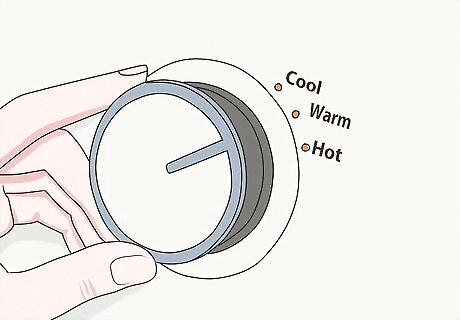
For washing: The permanent press setting uses warm water instead of hot, plus a second rinse with cooler water. It also uses a more gentle spin cycle than the regular wash setting, preventing creases and wrinkles from forming in the fabric. Fancier washing machines let you tweak the permanent press setting even further, like changing the water temperature or spin cycle time.
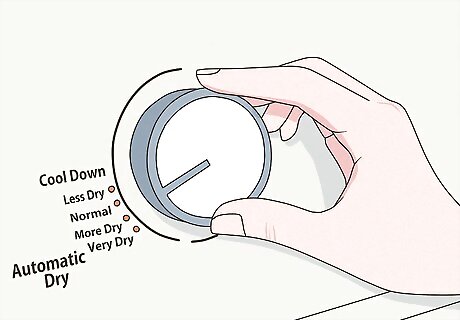
For drying: Your dryer’s permanent press setting uses medium heat, instead of the usual high head. This is usually followed by a cool-down period so that your clothes come out cooler to the touch. The cooler fabric is less likely to develop creases when you fold your laundry. More expensive dryers let you adjust the temperature or drying time. Some even have sensors that automatically stop the cycle when your laundry is fully dry.
Pros & Cons of Permanent Press

Pro: It works well for lightweight, moderately soiled clothes. Colored shirts, pants, dresses, t-shirts, scarves, and socks are best. You can also use permanent press for workout clothes made from synthetic fiber. For better results, always sort your laundry by color. This helped prevent darker items from fading and lighter ones from getting stained or discolored. Use hotter water for heavily soiled items, or items that need to be sanitized.

Pro: It’s perfect for washing clothes made from synthetic fabrics. These can include items made from polyester, nylon, rayon, and knitwear. You can also use it for non-iron fabrics made from a blend of natural and synthetic fibers. Some fabric blends may require specific settings, like lower water temperature or drying without heat. Check the item tags to confirm which fabrics are used in your item. If you can’t find the tags and aren’t sure what fabric your item is made from, you can hand-wash it and hang it to dry to prevent damage.
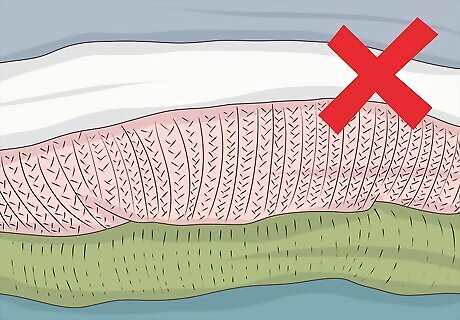
Con: It’s not recommended for delicates like lace, silk, or wool. These items are prone to get damaged by machine washing, even if you use permanent press. Use the “delicates” setting to clean these items, or hand wash them instead. It’s also not good for sequins or older garments that may come apart during the spin cycle.

Con: It’s not ideal for heavy items like jeans, blankets, and towels. Some of these items may require a more intense wash cycle with hotter water. Most blue jeans shouldn’t be washed at all, especially if they’re made with raw denim. Certain heavy items like coats, comforters, and expensive sweaters should only be dry cleaned. Check clothing tags to confirm if this is the case.
When & How to Use Permanent Press

Check item tags for the permanent press symbols. You can find these tags on clothes, towels, linens, and many other items. There are two symbols: one for washing, and another for drying. The washing permanent press symbol is shaped like a cup with a wavy top, plus one black line underneath the cup. The dryer permanent press symbol is shaped like a square with a large circle in the middle, plus a single black line below the square. Always use the permanent press setting for items featuring these symbols on their tags. The washer symbol can also have 1-4 dots, which indicate the water temperature. One dot means you should use cold water, two means “normal” temperature, three means warm, and four means hot water. Zero dots simply means “permanent press,” with no extra info on water temperature. The dryer symbol will sometimes have a solid black circle, or a circle with 1-3 dots. A solid black circle means you should use no heat while tumble-drying your clothes. One dot means low heat, two means medium heat, and three means high heat. If the circle is empty, it simply means “permanent press,” with no extra info on temperature.

Lightly pack the laundry into the washer when you run it. Add detergent, softener, and other cleaning agents as needed. Don’t press down on your clothes or overfill the machine, since this will cause more wrinkles. Then select “Permanent Press” and let the machine run a full cycle. Make sure to follow any directions printed on your washer. For instance, there may be a limit to how high you should fill the washer when using the permanent press setting.

Move your wet clothes to the dryer right away to prevent wrinkles. Letting them sit for too long can cause creases and wrinkles to develop in the wet fabric, which may still be visible after they’re dried. Lightly place the clothes into the dryer. Don’t overfill it or stuff the clothes in. Then select “Permanent Press” and dry your clothes for 30-60 minutes. Some dryers have sensors that automatically stop the machine when the laundry is dry. If your machine does this, make sure to check on it periodically to avoid leaving the dry clothes sitting in the dryer after the cycle is finished.

After the dryer is done, remove your items right away. Avoid letting them sit unfolded in the dryer, or they may develop wrinkles and creases again. Fold or hang items up and put them away as soon as possible. A few items may still have creases and wrinkles. Iron these right away to prevent them from getting worse.
A Quick Guide to the Other Settings

Regular Wash & Dry: This all-purpose setting usually uses warm or hot water and a normal spin cycle, followed by a drying cycle with high heat. The hot water is great for removing stains and dirt, while the high heat dries everything quickly and efficiently. Washers and dyers use this setting by default. This setting works well for heavily soiled, light-colored, non-delicate items made from natural fabrics, like cotton. Use colder water for darker clothes to prevent colors from washing out.
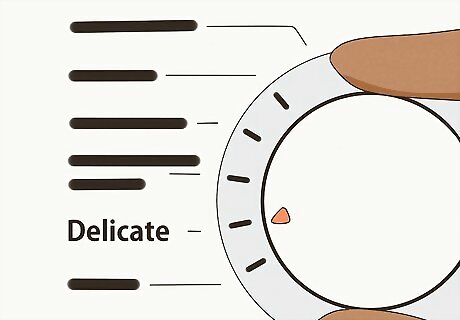
Knits/Delicates: This setting is designed to protect fragile items like lace and knitted fabrics. Warm water is combined with a brief, gentle spin cycle to stop items from getting ripped or tangled. For drying, most machines will use warm air or no heat at all. This prevents fabrics from shrinking or getting damaged by the heat. The knits/delicates wash cycle may take longer, since the machine will spin and mix its contents more gently to protect your items. The dry cycle may also take longer since the temperature will be much lower than normal.

Colors/Darks: This washer setting uses colder water to prevent colored fabrics from fading. This keeps clothes looking newer for longer. In general, you should always use this setting for dark and black items. Cold water isn’t ideal for getting rid of stains or odors. Use hot water for this, but keep in mind that your dark items may fade as a result.

Quick/rapid wash: This setting will wash your clothes in less time than a regular wash cycle. Use it if you’re in a hurry, or if your items aren’t particularly dirty. Keep in mind that the spin cycle will be faster too, so your clothes may come out a bit wetter. dirty. A quick/rapid wash isn’t as thorough as a regular wash, so it’s not recommended for very dirty or smelly items.
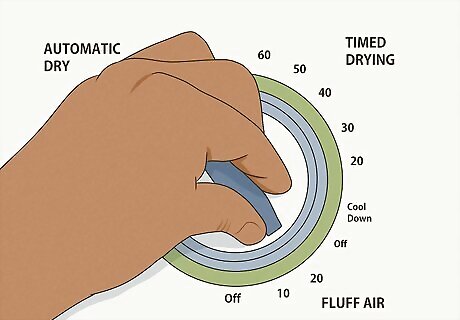
Air fluff: This dryer setting dries your items with cool or room-temperature air. Use it for delicate fabrics or items that are prone to shrinking, like jeans or sweaters. This setting is also more energy efficient since it doesn’t use heat. Drying with cool air can take a lot longer than using hot air. For better results, dry only a few items at a time.













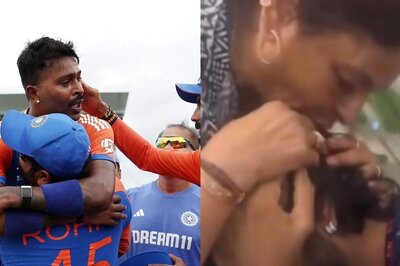


Comments
0 comment